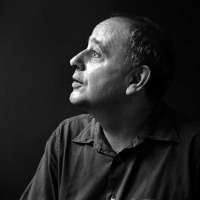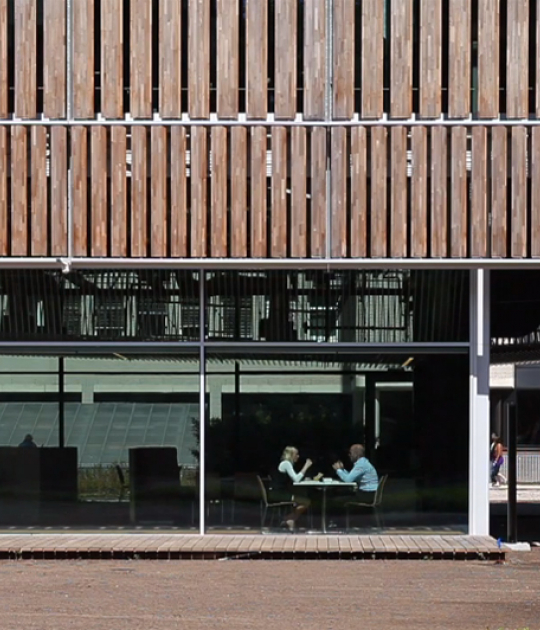The project by Mateo Arquitectura is located nearby the city of Zeist, close to Utrecht, the tender put forward the requirement for increasing the offices in the current building by 25,000 sqm, and at the same time recover a park by means of the construction of a 25,000 sqm underground car park. The project takes into consideration the relationship with the enviroment and the surrounding neighbourhood buildings in order to maintain compactness which recovers the logic of the increase in size of the inicial building.
Description of project by Mateo Arquitectura
In 2003, Josep Lluís Mateo won the bid for the extension of what was to be the new head office of Dutch insurance company PGGM, in the city of Zeist. The competition addressed the need to add 25,000 sqm of office space to the existing building, at the same time recovering a park by constructing an underground car park of 25,000 sqm.
The existing constructions followed a north-south axis laid out in a landscape of very dense greenery. The conservation, reinforcement and intensification of the qualities intrinsic to this landscape form the basis for the project.
Integration of New Building and Landscape Integration is achieved by means of the lightness and visual permeability of the materials used for the new building, ensuring that the visual relation between inside and outside is complete and direct.
Car-parking space at grade is relocated in the new underground car park, freeing up the entire park for a landscape of continuous greenery.
Integration of New and Existing
The volume of the new building emerges as a layout in keeping with that of the original building. The pre-existing building was made up of different wings of offices that intersected, leaving a kind of cloister or “patio” between. Continuing this logic, a new layout appears in the south of the site. This layout is configured by two large, elongated office wings, intersected by small connecting buildings that spatially connect the new with the existing.
Into the open space inside the existing building, a transparent volume is introduced, raised above ground level. The crossshape of this volume is superposed and adapted to integrate and communicate with the surrounding buildings. The addition of this “patio building” is a functional solution to the long distances in the existing building.
Technology at the Service of Sustainability
Acoustic and visual comfort, comfort of the working environment, quality in outdoor spaces, and sustainable construction systems and procedures are the factors guiding the practice’s architectural and aesthetic reflection. This is manifested by the sophisticated ventilation systems, built into the building’s false ceilings to naturally filter outdoor air to condition the various spaces. This more natural means of filtering represents a major energy saving and frees the building of tubes and machinery that would visually and acoustically interfere in the working environment.
Not Just Functionality
The building and its furniture and fittings are designed to adapt to various working methods, offering flexible spaces with multiple possibilities to allow workers to choose the place in the building where they want to work. Further, spaces for relaxation and personal recreation are also envisaged, along with areas like the Boulevard, providing the casual encounters, extraordinary ease and informal spaces characteristic of temporary work.
Guided Tour
The building emerges from a large park and takes its place naturally in a continuous landscape of greenery, respecting the great canopies of the trees.
A semi-paved pathway leads to the main entrance, marked by the monolithic volume of the auditorium, suspended between the two office wings. Its Cor-ten steel façade dialogues with the canopy of the trees and their changing foliage.
Beneath the auditorium, the building’s entrance leads into the reception, on the left, which guides visitors to the main foyer and the building’s public area. The main foyer is a double-height space situated between the two office wings, where large skylights provide overhead lighting.
On the right is the restaurant, with an adjoining terrace and a visual relation with the garden and the landscape. The special geometry of the roof dialogues with the immediate natural space.
The south office wing rises above the restaurant. Its façade is chosen as the main frontage of the new construction. It is clad with a second skin of wooden slats that protect the building from solar radiation, functionally and aesthetically becoming a mediator between construction and nature.
On the left is the Grand Café, a meeting space that communicates visually with the existing building and the garden area in the east. Above the Grand Café is the north office wing, which, in contrast to the warmth of the south wing, is characterized by its lightness and shiny materials: stainless steel, aluminium, concrete and painted glass.
The upper office levels are generally organized to provide the flexibility and adaptability needed by contemporary corporate life. The roof is designed with a single technology to integrate requirements of ventilation, lighting and aesthetics for this kind of space.
The new and the existing buildings are connected by the Boulevard, which provides a thoroughfare between the two. It is devised as a sequence of different indoor spaces. Facing south, a picture window looks out onto the surroundings and allows light to flood in through warm-toned glass. To the north, meanwhile, the spaces vary gradually, ranging from transparent and light to darker, more enclosed spaces at the intersection with the existing building.
Beyond the first wing of the building lies the “patio building”, floating above the garden of the existing cloister. The materiality of its interior spaces evokes lightness, transparency and reflectivity.
In addition to the Boulevard connecting the new and the existing buildings, there are also “bridge” buildings that respond to the volumes of the projections from the south-facing side of the original building. They are lightweight in appearance, with emphasis on the use of transparent glass and a direct visual relation with the gardens beyond.
The car park, finally, is a simple structure of three basement floors with capacity for some 1,000 cars, motorcycles and bicycles, with an independent entrance for cyclists. Like the rest of the new building, the car park seeks maximum energy efficiency, with large lengthwise slits and two central courtyards that filter daylight and provide natural ventilation.
CREDITS. TECHNICALSHEET.-
Architect.- PGGM Headquarters - Mateo Arquitectura / Josep Lluís Mateo
Area.- 25,000.0 sqm
Project dates.- 2003-2005
Construction dates.- 2008-2013
Surface.- 25,000 m² offices + 25,000 m² parking spaces
Site.- Zeist (Utrecht), Holland













































